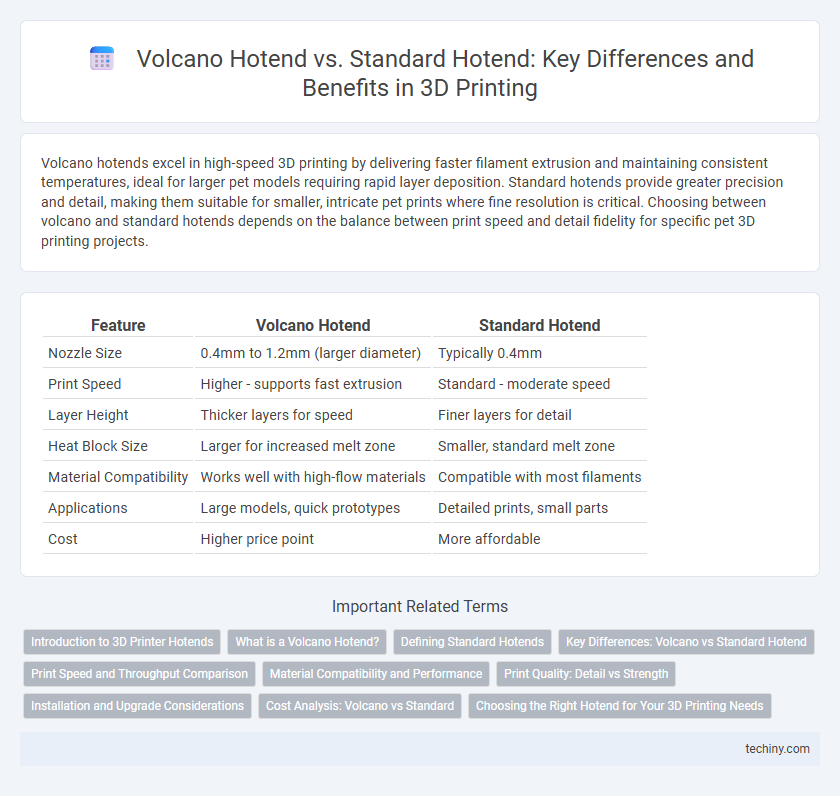Volcano hotends excel in high-speed 3D printing by delivering faster filament extrusion and maintaining consistent temperatures, ideal for larger pet models requiring rapid layer deposition. Standard hotends provide greater precision and detail, making them suitable for smaller, intricate pet prints where fine resolution is critical. Choosing between volcano and standard hotends depends on the balance between print speed and detail fidelity for specific pet 3D printing projects.
Table of Comparison
| Feature | Volcano Hotend | Standard Hotend |
|---|---|---|
| Nozzle Size | 0.4mm to 1.2mm (larger diameter) | Typically 0.4mm |
| Print Speed | Higher - supports fast extrusion | Standard - moderate speed |
| Layer Height | Thicker layers for speed | Finer layers for detail |
| Heat Block Size | Larger for increased melt zone | Smaller, standard melt zone |
| Material Compatibility | Works well with high-flow materials | Compatible with most filaments |
| Applications | Large models, quick prototypes | Detailed prints, small parts |
| Cost | Higher price point | More affordable |
Introduction to 3D Printer Hotends
3D printer hotends are critical components that melt and extrude filament to form printed objects, with Volcano hotends designed for faster printing through higher flow rates and larger nozzle sizes compared to standard hotends. Volcano hotends can reach temperatures up to 300degC and support printing with high-viscosity materials, enhancing speed and layer adhesion on large-scale prints. Standard hotends typically offer more precise extrusion for detailed prints but operate at lower maximum temperatures, making them suitable for a wider range of common filaments like PLA and ABS.
What is a Volcano Hotend?
A Volcano Hotend is a specialized 3D printer component designed for high-speed printing with larger nozzles, typically ranging from 0.6mm to 1.2mm. It features an extended heater block and heat break, allowing faster melting and extrusion of filament compared to standard hotends with smaller nozzles. This design enables significantly increased layer deposition rates and improved efficiency for large-scale or rapid prototyping projects.
Defining Standard Hotends
Standard hotends in 3D printing typically feature a compact design with a single heat break and a smaller melt zone, optimized for printing materials like PLA and ABS at moderate speeds. They use a brass or steel nozzle with diameters commonly ranging from 0.2mm to 0.4mm, providing detail and precision in standard applications. These hotends operate efficiently at temperatures up to 250degC, making them suitable for most everyday filament types and general-purpose 3D printing tasks.
Key Differences: Volcano vs Standard Hotend
Volcano hotends feature an extended melt zone and larger nozzle diameter, enabling higher extrusion rates and faster print speeds compared to standard hotends. Standard hotends provide finer layer resolutions with smaller nozzles, making them ideal for detailed and precise prints. The choice between volcano and standard hotends depends on whether speed or print quality is the primary priority in 3D printing projects.
Print Speed and Throughput Comparison
Volcano hotends enable significantly faster print speeds by utilizing a longer melt zone and a larger nozzle diameter, allowing for higher filament flow rates compared to standard hotends. This increased throughput reduces print times for large objects or high-volume production without compromising layer adhesion. Standard hotends excel in detailed prints at slower speeds but are limited in maximum extrusion rates and overall throughput.
Material Compatibility and Performance
Volcano hotends excel in printing high-temperature materials like ABS, PETG, and Nylon due to their larger melt zone, enabling faster extrusion rates and improved layer adhesion. Standard hotends typically handle lower-temperature filaments such as PLA and TPU, offering precise detail but limited speed and thermal capacity. Choosing between Volcano and standard hotends directly impacts printing performance and material versatility in advanced 3D printing applications.
Print Quality: Detail vs Strength
Volcano hotends excel in high-speed printing, producing strong, thicker layers ideal for functional parts, but may sacrifice fine detail resolution due to larger nozzle sizes. Standard hotends deliver superior print quality with finer details by utilizing smaller nozzles, making them suitable for intricate models and prototypes. Choosing between a volcano and standard hotend depends on prioritizing layer strength and print speed versus detailed surface finish.
Installation and Upgrade Considerations
Volcano Hotends offer a larger heater block and extended nozzle length, requiring careful alignment and potential firmware adjustments during installation compared to Standard Hotends. Upgrading to a Volcano may involve modifying existing printer mounts and ensuring compatible thermistors and heater cartridges to maintain accurate temperature control. Proper installation and calibration are essential to fully leverage the improved high-flow extrusion capabilities of Volcano Hotends without compromising print quality.
Cost Analysis: Volcano vs Standard
Volcano hotends generally have a higher upfront cost compared to standard hotends due to their larger size and enhanced high-flow capabilities, which allow for faster printing speeds and thicker layer heights. Standard hotends offer a more budget-friendly option with sufficient performance for detailed prints, making them ideal for hobbyists or those on a tighter budget. Over time, the Volcano's efficiency in reducing print times can offset its initial expense, especially in production environments where volume and speed are prioritized.
Choosing the Right Hotend for Your 3D Printing Needs
Volcano hotends excel in high-speed 3D printing by offering larger nozzle sizes and faster filament melting, ideal for big, bulky projects requiring rapid material deposition. Standard hotends provide superior precision with smaller nozzles, making them perfect for detailed prints and complex geometries needing fine layer resolution. Selecting the right hotend depends on balancing print speed, resolution, and material compatibility to optimize performance for specific 3D printing tasks.
Volcano Hotend vs Standard Hotend Infographic

 techiny.com
techiny.com